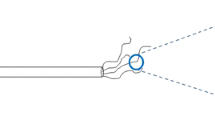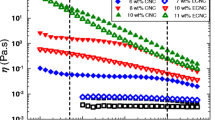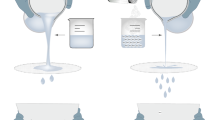Abstract
Understanding rheological properties of dispersions of cellulose nanomaterials such as cellulose nanofiber (CNF) and cellulose nanocrystal (CNC) has received tremendous attentions from scientific and industrial viewpoints. To gain insight into the effect of aggregation-dispersion of CNF on the sol–gel state of aqueous CNF suspensions, simple turnover tests were performed for semi-dilute CNF suspensions as a function of pH and potassium chloride (KCl) concentration. Experimental results revealed that the gel state was confirmed around 20–100 mM KCl depending on pH, and the sol state was observed at higher or lower KCl concentrations. The upper and lower boundaries between gel and sol states were 20 and 80 mM around pH 4, and 50 and 120 mM around pH 7. These boundaries were discussed using the angle-dependent Derjaguin-Landau-Verwey-Overbeek (DLVO) theory for cylindrical particles. From the discussion, we presume that the gel of semi-dilute CNF suspension can be formed when the aggregation is allowed at the orientation angle between 45 and 90°. Aggregation at orientation angles below 30° can occur at high KCl concentration and might result in sol state due to the formation of aggregate with compact structure, which cannot allow the network structure in the whole suspension.





Similar content being viewed by others
References
Saito T, Kimura S, Nishiyama Y, Isogai A (2007) Cellulose nanofibers prepared by TEMPO-mediated oxidation of native cellulose. Biomacromol 8:2485–2491. https://doi.org/10.1021/bm0703970
Isogai A (2013) Wood nanocelluloses: fundamentals and applications as new bio-based nanomaterials. J Wood Sci 59:449–459. https://doi.org/10.1007/s10086-013-1365-z
Reid MS, Villalobos M, Cranston ED (2017) Benchmarking cellulose nanocrystals: from the laboratory to industrial production. Langmuir 33:1583–1598. https://doi.org/10.1021/acs.langmuir.6b03765
Delepierre G, Vanderfleet OM, Niinivaara E et al (2021) Benchmarking cellulose nanocrystals Part II: New industrially produced materials. Langmuir la-2021–00550w. https://doi.org/10.1021/acs.langmuir.1c00550
Kalia S, Boufi S, Celli A, Kango S (2014) Nanofibrillated cellulose: surface modification and potential applications. Colloid Polym Sci 292:5–31. https://doi.org/10.1007/s00396-013-3112-9
Tavakolian M, Jafari SM, van de Ven TGM (2020) A review on surface-functionalized cellulosic nanostructures as biocompatible antibacterial materials. Nano-Micro Lett 12:73. https://doi.org/10.1007/s40820-020-0408-4
Tan HF, Ooi BS, Leo CP (2020) Future perspectives of nanocellulose-based membrane for water treatment. J Water Process Eng 37:101502. https://doi.org/10.1016/j.jwpe.2020.101502
Halim A, Xu Y, Lin K-H et al (2019) Fabrication of cellulose nanofiber-deposited cellulose sponge as an oil-water separation membrane. Sep Purif Technol 224:322–331. https://doi.org/10.1016/j.seppur.2019.05.005
Yadav C, Saini A, Zhang W et al (2021) Plant-based nanocellulose: a review of routine and recent preparation methods with current progress in its applications as rheology modifier and 3D bioprinting. Int J Biol Macromol 166:1586–1616. https://doi.org/10.1016/j.ijbiomac.2020.11.038
Kupnik K, Primožič M, Kokol V, Leitgeb M (2020) Nanocellulose in drug delivery and antimicrobially active materials. Polymers (Basel) 12:1–40. https://doi.org/10.3390/polym12122825
Vu CM, Nguyen DD, Sinh LH et al (2017) Environmentally benign green composites based on epoxy resin/bacterial cellulose reinforced glass fiber: fabrication and mechanical characteristics. Polym Test 61:150–161. https://doi.org/10.1016/j.polymertesting.2017.05.013
Liu H, Geng S, Hu P et al (2015) Study of pickering emulsion stabilized by sulfonated cellulose nanowhiskers extracted from sisal fiber. Colloid Polym Sci 293:963–974. https://doi.org/10.1007/s00396-014-3484-5
Zhou H, Xu Z, Zhou G, Xu X (2021) Optical modeling of cellulose nanofibril self-assembled thin film with iridescence. Colloid Polym Sci 299:1139–1145. https://doi.org/10.1007/s00396-021-04834-5
Liu S, Low Z, Xie Z, Wang H (2021) TEMPO-oxidized cellulose nanofibers: a renewable nanomaterial for environmental and energy applications. Adv Mater Technol 6:2001180. https://doi.org/10.1002/admt.202001180
Kim H, Guccini V, Lu H et al (2019) Lithium ion battery separators based on carboxylated cellulose nanofibers from wood. ACS Appl Energy Mater 2:1241–1250. https://doi.org/10.1021/acsaem.8b01797
Qu R, Wang Y, Li D, Wang L (2021) Rheological behavior of nanocellulose gels at various calcium chloride concentrations. Carbohydr Polym 274:118660. https://doi.org/10.1016/j.carbpol.2021.118660
Alves L, Ferraz E, Lourenço AF et al (2020) Tuning rheology and aggregation behaviour of TEMPO-oxidised cellulose nanofibrils aqueous suspensions by addition of different acids. Carbohydr Polym 237:116109. https://doi.org/10.1016/j.carbpol.2020.116109
Sato Y, Kusaka Y, Kobayashi M (2017) Charging and aggregation behavior of cellulose nanofibers in aqueous solution. Langmuir 33:12660–12669. https://doi.org/10.1021/acs.langmuir.7b02742
Lin K-H, Hu D, Sugimoto T et al (2019) An analysis on the electrophoretic mobility of cellulose nanocrystals as thin cylinders: relaxation and end effect. RSC Adv 9:34032–34038. https://doi.org/10.1039/C9RA05156B
Mendoza DJ, Hossain L, Browne C et al (2020) Controlling the transparency and rheology of nanocellulose gels with the extent of carboxylation. Carbohydr Polym 245:116566. https://doi.org/10.1016/j.carbpol.2020.116566
Araki J (2013) Electrostatic or steric? – preparations and characterizations of well-dispersed systems containing rod-like nanowhiskers of crystalline polysaccharides. Soft Matter 9:4125. https://doi.org/10.1039/c3sm27514k
Fukuzumi H, Tanaka R, Saito T, Isogai A (2014) Dispersion stability and aggregation behavior of TEMPO-oxidized cellulose nanofibrils in water as a function of salt addition. Cellulose 21:1553–1559. https://doi.org/10.1007/s10570-014-0180-z
Russel WB, Saville DA, Schowalter WR (1992) Colloidal dispersions. Cambridge University Press
Mewis J, Wagner NJ (2012) Colloidal suspension rheology. Cambridge University Press
Kawasaki S, Kobayashi M (2018) Affirmation of the effect of pH on shake-gel and shear thickening of a mixed suspension of polyethylene oxide and silica nanoparticles. Colloids Surfaces A Physicochem Eng Asp 537:236–242. https://doi.org/10.1016/j.colsurfa.2017.10.033
Kobayashi M, Adachi Y, Ooi S (2000) On the steady shear viscosity of coagulated suspensions. Nihon Reoroji Gakkaishi 28:143–144
Tsujimoto Y, Yoshida A, Kobayashi M, Adachi Y (2013) Rheological behavior of dilute imogolite suspensions. Colloids Surfaces A Physicochem Eng Asp 435:109–114. https://doi.org/10.1016/j.colsurfa.2012.12.041
Kobayashi M, Skarba M, Galletto P et al (2005) Effects of heat treatment on the aggregation and charging of Stöber-type silica. J Colloid Interface Sci 292:139–147. https://doi.org/10.1016/j.jcis.2005.05.093
Huang Y, Yamaguchi A, Pham TD, Kobayashi M (2018) Charging and aggregation behavior of silica particles in the presence of lysozymes. Colloid Polym Sci 296:145–155. https://doi.org/10.1007/s00396-017-4226-2
Behrens SH, Christl DI, Emmerzael R et al (2000) Charging and aggregation properties of carboxyl latex particles: experiments versus DLVO theory. Langmuir 16:2566–2575. https://doi.org/10.1021/la991154z
Kobayashi M, Yuki S, Adachi Y (2016) Effect of anionic surfactants on the stability ratio and electrophoretic mobility of colloidal hematite particles. Colloids Surfaces A Physicochem Eng Asp 510:190–197. https://doi.org/10.1016/j.colsurfa.2016.07.063
Verwey EJW, Overbeek JTG (1948) Theory of the stability of lyophobic colloids. Elsevier
Derjaguin B, Landau L (1941) The theory of stability of highly charged lyophobic sols and coalescence of highly charged particles in electrolyte solutions. Acta Physicochim URSS 14:633–662
Kobayashi M, Juillerat F, Galletto P et al (2005) Aggregation and charging of colloidal silica particles: effect of particle size. Langmuir 21:5761–5769. https://doi.org/10.1021/la046829z
Kobayashi M, Nitanai M, Satta N, Adachi Y (2013) Coagulation and charging of latex particles in the presence of imogolite. Colloids Surfaces A Physicochem Eng Asp 435:139–146. https://doi.org/10.1016/j.colsurfa.2012.12.057
Klein S, Fisher M, Franks G et al (2001) Effect of the interparticle pair potential on the rheological behavior of zirconia powders: II, The influence of chem-adsorbed silanes. J Am Ceram Soc 84:991–995. https://doi.org/10.1111/j.1151-2916.2001.tb00780.x
Johnson SB, Franks G V, Scales PJ et al (2000) Surface chemistry – rheology relationships in concentrated mineral suspensions. 267–304
Yamaguchi A, Kobayashi M, Adachi Y (2019) Yield stress of mixed suspension of silica particles and lysozymes: The effect of zeta potential and adsorbed amount. Colloids Surfaces A Physicochem Eng Asp 578:123575. https://doi.org/10.1016/j.colsurfa.2019.123575
Nakamura H, Makino S, Ishii M (2021) Effects of electrostatic interaction on rheological behavior and microstructure of concentrated colloidal suspensions. Colloids Surfaces A Physicochem Eng Asp 623:126576. https://doi.org/10.1016/j.colsurfa.2021.126576
Tsujimoto Y, Kobayashi M, Adachi Y (2014) Viscosity of dilute Na-montmorillonite suspensions in electrostatically stable condition under low shear stress. Colloids Surfaces A Physicochem Eng Asp 440:20–26. https://doi.org/10.1016/j.colsurfa.2012.11.005
Oguzlu H, Danumah C, Boluk Y (2017) Colloidal behavior of aqueous cellulose nanocrystal suspensions. Curr Opin Colloid Interface Sci 29:46–56. https://doi.org/10.1016/j.cocis.2017.02.002
Boger DV, Wierenga AM, Philipse AP, Lekkerkerker HNW (1998) Aqueous dispersions of colloidal boehmite: structure, dynamics, and yield stress of rod gels. Langmuir 7463:55–65
Sipos P, May PM, Hefter GT (2000) Carbonate removal from concentrated hydroxide solutions. Analyst 125:955–958. https://doi.org/10.1039/a910335j
Israelachvili JN (2011) Intermolecular and surface forces, 3rd edn. Elsevier
Ohshima H (1998) Surface charge density/surface potential relationship for a cylindrical particle in an electrolyte solution. J Colloid Interface Sci 200:291–297. https://doi.org/10.1006/jcis.1998.5433
Acknowledgements
The authors are thankful to the financial support by JSPS KAKENHI (19H03070, 21K14939).
Author information
Authors and Affiliations
Corresponding author
Ethics declarations
Conflict of interest
The authors declare no competing interests.
Additional information
Publisher's Note
Springer Nature remains neutral with regard to jurisdictional claims in published maps and institutional affiliations.
Rights and permissions
About this article
Cite this article
Kobayashi, M., Sato, Y. & Sugimoto, T. Effect of pH and electrolyte concentration on sol–gel state of semi-dilute aqueous cellulose nanofiber suspension: an interpretation based on angle-dependent DLVO theory. Colloid Polym Sci 300, 953–960 (2022). https://doi.org/10.1007/s00396-022-04999-7
Received:
Revised:
Accepted:
Published:
Issue Date:
DOI: https://doi.org/10.1007/s00396-022-04999-7




